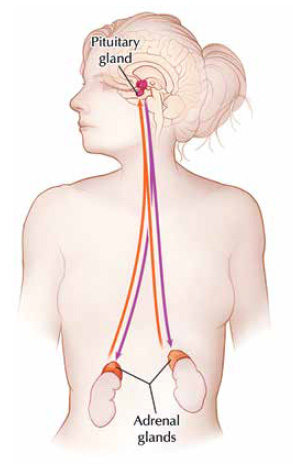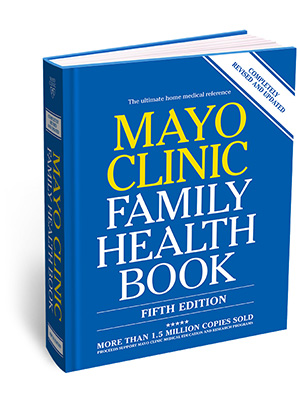- Cortisol — This helps your body respond to stress, such as from an injury or infection. It also helps glucose metabolism and helps with proper cardiovascular function.
- Aldosterone — This helps maintain proper blood pressure through the balance of sodium, potassium and water in the body.
There are two main categories of adrenal insufficiency:
- Primary adrenal insufficiency — This occurs when your adrenal gland is diseased or damaged. Most often, this takes the form of a long-term (chronic) disease — Addison's disease — that occurs when your own immune system mistakenly attacks and destroys adrenal gland tissues.
- Secondary adrenal insufficiency — The pituitary gland, located in the brain, makes a hormone called adrenocorticotropic hormone, which stimulates the adrenal gland to produce cortisol. If the pituitary gland is somehow damaged or altered, it can affect adrenal gland cortisol secretion, even if the adrenal gland is healthy. Secondary adrenal insufficiency is most commonly caused by medications, such as prednisone or intra-articular injections with steroids or steroid creams. In this situation, the adrenal gland may take days to months to recover its function and restore proper cortisol production.
Progressive symptoms
Signs and symptoms of adrenal insufficiency often come on gradually and progressively worsen over months. Diagnosis is sometimes delayed because early symptoms can easily be mistaken for something else. The most common signs and symptoms include:
- Muscle weakness, fatigue
- Muscle, joint or abdominal pains
- Decreased appetite and weight loss
However, signs and symptoms can also include lightheadedness, feeling wiped out by an ordinary illness, depression, nausea, vomiting or diarrhea. Salt craving or darkening of skin, especially on the face and hands, or on moles, scars or skin folds, is seen only with primary adrenal insufficiency.
These symptoms can suddenly and rapidly develop into an adrenal crisis. This can occur in someone who has been diagnosed with adrenal insufficiency or in someone who has yet to be diagnosed. Often, an adrenal crisis is triggered by health-related stress, such as an illness, surgical procedure or serious injury. These are also the times that higher cortisol production would usually occur in someone without adrenal insufficiency.
As symptoms of adrenal crisis escalate, most people feel terrible — perhaps with severe abdominal pain, nausea, vomiting and lightheadedness. They appropriately realize that emergency care is required and seek it out. Some people may pass out, requiring help from others. An adrenal crisis can result in death if not promptly treated.
Stabilizing hormones
Adrenal insufficiency can be confirmed or ruled out with blood tests. Although there's no cure, primary adrenal insufficiency can be effectively managed by taking cortisol and aldosterone replacement hormones. The goal is to stabilize hormone levels and relieve signs and symptoms.
Cortisol is replaced by an oral corticosteroid such as hydrocortisone, while aldosterone is replaced by an oral mineralocorticoid called fludrocortisone. The dose is often adjusted based on signs of undertreatment — such as incomplete relief of symptoms — or signs of overtreatment, such as weight gain or puffy skin.
Treatment plans also involve preparation for the possibility of an adrenal crisis. Have an individualized, written action plan for times when you may be at heightened risk of adrenal crisis — including during times of health stress such as an illness or medical procedure — and also for times when worsening symptoms indicate you may be headed toward an adrenal crisis.




